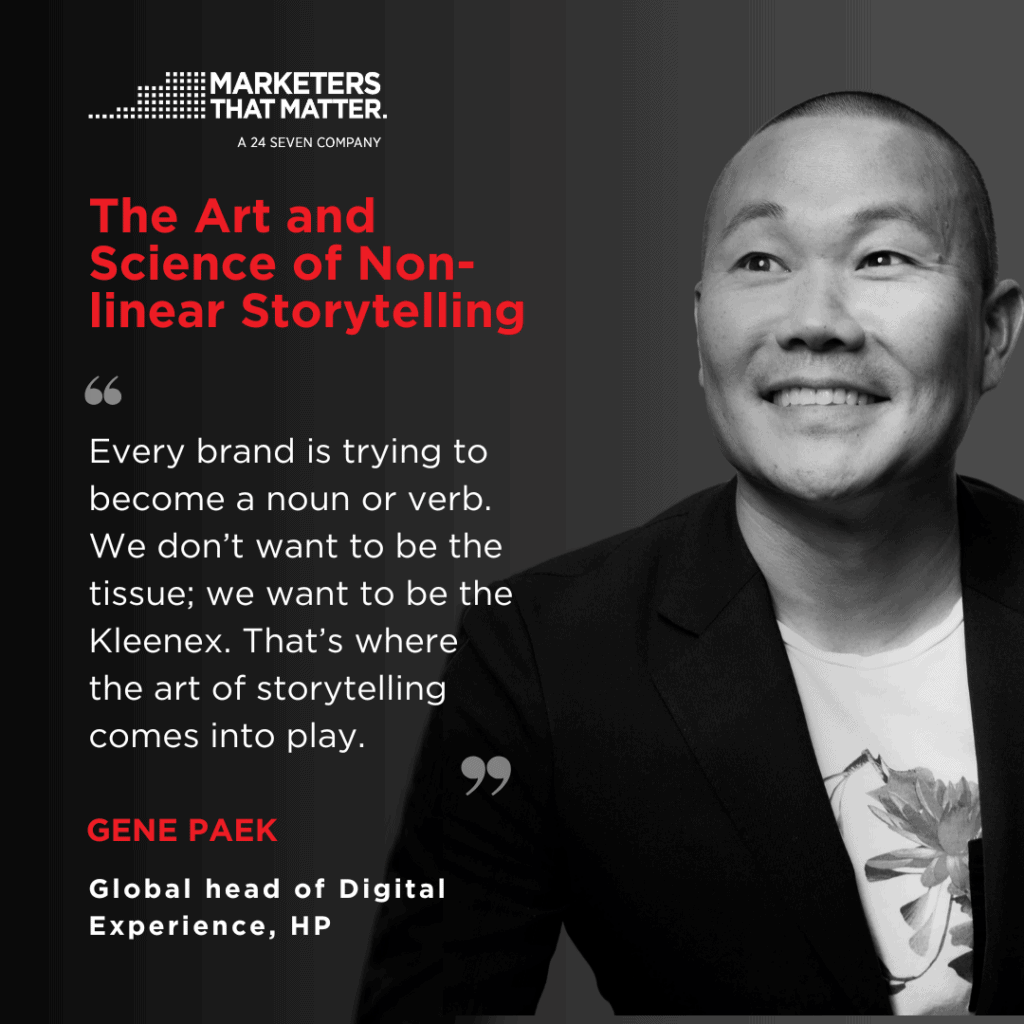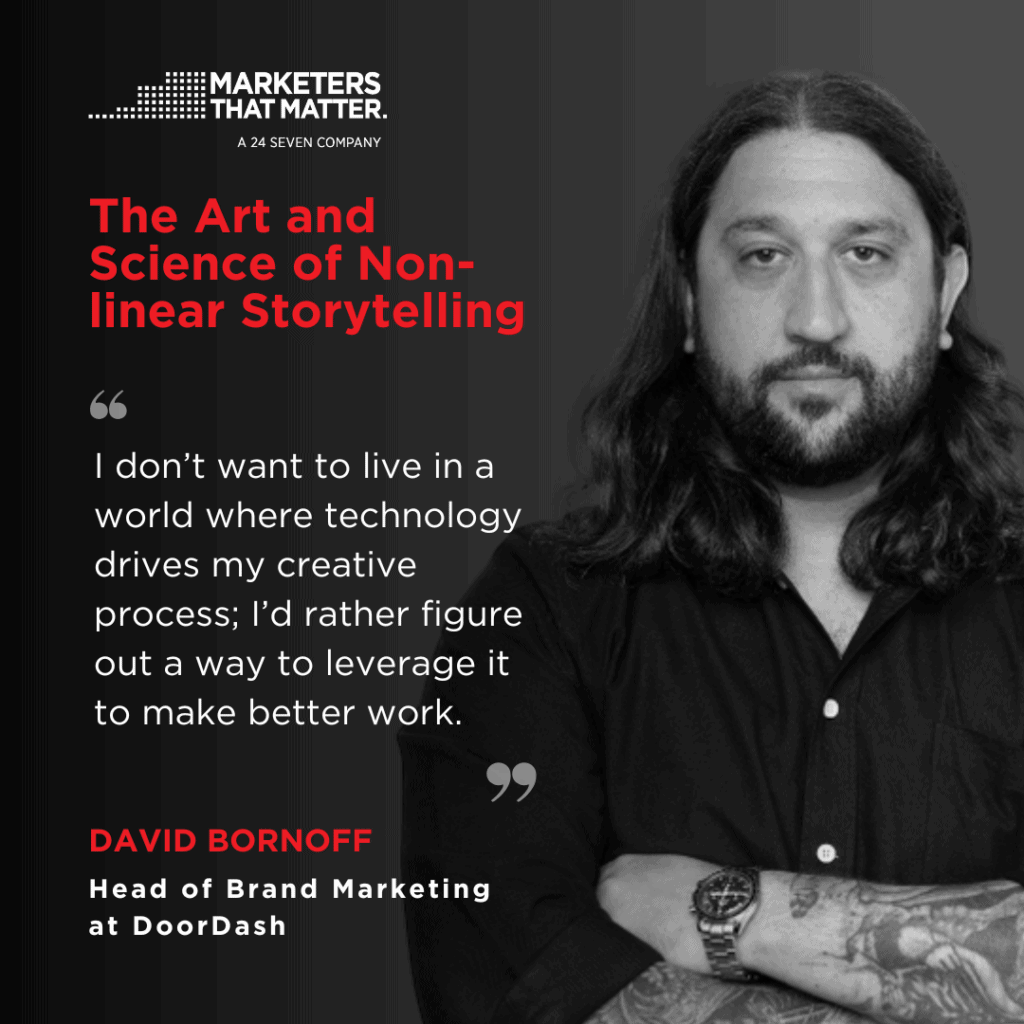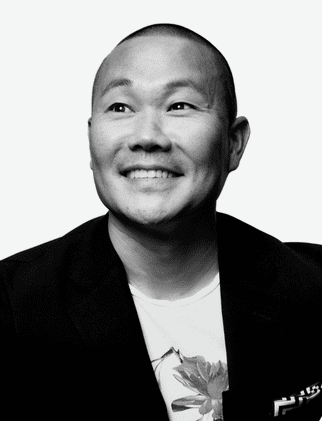In a world supercharged with countless channel options and new technologies, marketers have to iterate content in multiple formats to tell their story well. How do the best brand storytellers of our time ensure they “stick the landing” no matter where their content shows up? It requires a marketer who thinks like a scientist and works like an artisan to master non-linear storytelling in our current age.
We brought together two Visionaries who encompass this style of marketing on the Visionaries Podcast. Having experienced storytelling and content creation from every side of the desk and across a variety of industries, David Bornoff, Head of Brand Marketing at DoorDash, and Gene Paek, Global Head of Digital Experience at Hewlett Packard (HP) help us unpack and provide a framework for consideration.
Find the MTM Visionaries Podcast On Apple, Spotify, Amazon, and more!
6 Things to Know About the Art and Science of Non-Linear Storytelling
#1 – Storytelling is essential to ensure your content sticks the landing
Every brand is trying to become a noun or verb. We don’t want to be the tissue; we want to be the Kleenex. We don’t want to look something up; we want to Google it. We don’t want to order food; we want to DoorDash it. That’s what we’re trying to do, and that’s where the art of storytelling comes into play when we deal with new technology and science.
– Gene Paek, HP

As brand marketers, we often find ourselves making TV ads, so the campaigns typically start from a TV objective. But how do we take that and slice it into all the other mediums? While creating the content, how do we make the assets for the format so that it’s native to the platform? The worst type of ad is when it’s obvious the medium itself was an afterthought. Content should be additive to the platform and experience. Otherwise, it reeks of advertising
– David Bornoff, DoorDash
The worst type of ad is when it’s obvious the medium itself was an afterthought. Content should be additive to the platform and experience. Otherwise, it reeks of advertising. – David Bornoff, DoorDash Share on X
#2 Start every brand story with an idea, then deliverables
First, start from the perspective of defining the story. Don’t think about it from a deliverable perspective; it’s all about the idea. Then ask how we will get this idea into the world and what channels will help us best communicate that. For example, does this idea require a Super Bowl-type platform? Is it a social idea? Is it a story that we’re going tell across multiple surfaces? How will we bring it into the product, push notifications, and all the places where we can interact with our consumers and create dialogue?
–David Bornoff
#3 Know the marketing story arc is evolving
When you think back to the digital days when the flash banner came out, we had to learn to play and get our marketing messages out in that medium. Even looking at where social media is today – we all remember when long-form content was our medium. Then the feed came about, and we had to go to short-form.
The story arc of how we tell our stories continually changes, and we have to adapt to new environments. That’s the fun part for marketers – nothing gets boring. And just when things are about to get stale, platforms change. The mediums change. We have to change.
Look at the TikTok effect; it’s not just changing the story arc but the pacing. Cuts are 0.5 to 0.7 seconds because the pacing has to be faster. All of that gives us the avenue to play and the ability to learn, but ultimately, it helps us grow in creativity.
–Gene Paek
#4 In the age of ChatGPT, iterate efficiently, but balance technology and humanity
ChatGPT, and similar AI technologies, are additives to the creative process; I don’t see them as a threat. The technologies that have come before have only proven that the hand of the creative matters. The person behind it will always make a difference and be what connects us to the work. Many of us haven’t figured out how we will use the technology, but I believe it’s one of those things that we embrace and fold into our process. I don’t want to live in a world where technology drives my creative process; I’d rather figure out a way to leverage it to make better work.
–David Bornoff

When chat GPT was deployed, there was this fear that it would take away from the creative industry. There’s a gentleman I used to work with named Ali Gallop, who had an interesting formula. He said if creators have the tools + a good idea + a lot of effort = dopamine (joy). But he said that if you take away the effort (ChatGPT), the dopamine disappears. Leveraging ChatGPT in your process requires effort, and there can be a creative aspect.
–Gene Paek
Those who use ChatGPT and AI tools to provide speed and agility or replace part of the creative process will miss out on the dopamine of creating. There's this element of humanity you need to maintain. - Gene Paek, HP Share on X#5 Never give up
You might post a piece of content and didn’t get the engagement or KPIs you were expecting. Post it again a few weeks later and see what happens. It could have been that the timing of that post didn’t land for the audience, because the algorithm didn’t kick in but keep posting. Post multiple times.
- Gene Paek
ChatGPT has a built-in constraint. It’s trained on the inputs we’ve given it, and it only knows what we know. That said, the more we inform these technologies, the better the outputs will be and the easier our work will be.
– David Bornoff
# 6 Look to the future
One of the aspects I see ChatGPT helping with is cultural listening at scale. Participating in every single conversation everywhere, across all audiences, psychographics, and demographics, is very hard. These tools will make that easier and more meaningful for the end user.
– David Bornoff
Summary
Storytelling has always been a part of humanity. It’s what brings communities together and lifts us up. As new technologies arise, there’s an urge to preserve and protect the treasured art and science of marketing–because, after all, marketers are storytellers. But as David and Gene reassured us, it’s the hand of the creative that matters. No matter how many new technologies arise, the art of storytelling will always win.
We leave you with Marketers That Matter’s GM, Nadine Dietz, favorite quote:
“In the end, it all comes down to people and values. We need to shape a future that works for all of us by putting people first and empowering them. In its most pessimistic, dehumanized form, the Fourth Industrial Revolution may indeed have the potential to “robotize” humanity and thus to deprive us of our heart and soul. But as a complement to the best parts of human nature—creativity, empathy, stewardship—it can also lift humanity into a new collective and moral consciousness based on a shared sense of destiny. It is incumbent on us all to make sure the latter prevails.
– Klaus Schwab, Founder and Executive Chairman of the World Economic Forum
Stayed tuned for part 2 of this conversation with Gene and David on how to effectively lead teams through change by signing up for our newsletter.
____________________________________
Meet The Visionaries

David Bornoff is the Head of Brand Marketing at DoorDash. Prior to DoorDash, David was Executive Director of Marketing at Pandora, having previously served as the company’s Creative Director. Before Pandora, David was Creative Director at Interbrand S.F., where he focused on three primary clients, Chevron, Google, and eBay. David is an AdWeek executive Mentor and an active member of the Google Intersections DE&I council. In 2020, David was named to the “40 under 40” list of global marketers and his work has received numerous creativity and campaign awards.

Gene Paek is the Global Head of Digital Experience at Hewlett Packard (HP). He started his career with interactive advertising and website development. He has a passion for advertising and marketing through digital channels. Within this scope, he worked for renowned agencies and companies and has specialized in social media marketing throughout his career. Before becoming the Global Head of Digital Experience and Innovation at HP, Gene was the VP of marketing of the social app VSCO. Prior to that, he was the Global Head of Business Marketing at Instagram.
Visionaries, hosted by Nadine Dietz, airs every week and is brought to you in partnership with The Wall Street Journal. Each week, two new visionaries share their game plan and how that impacts today’s teams, talent, and hybrid work environment.
Marketers That Matter® is a community of top marketing executives coming together to pioneer the future of marketing, sharing real-time experiences, and solving current challenges.
Our parent company, 24 Seven, specializes in helping you find exceptional marketing and creative talent for your teams.


